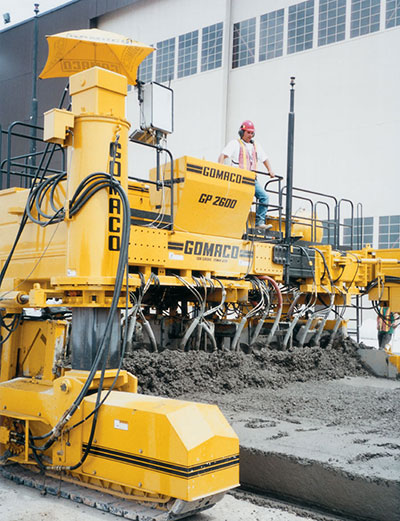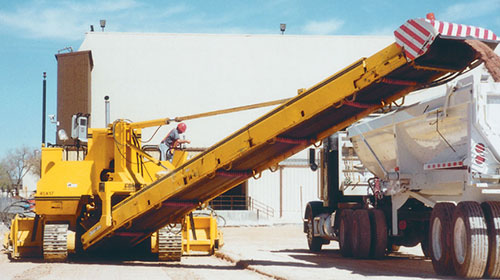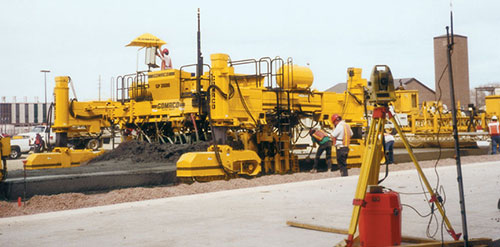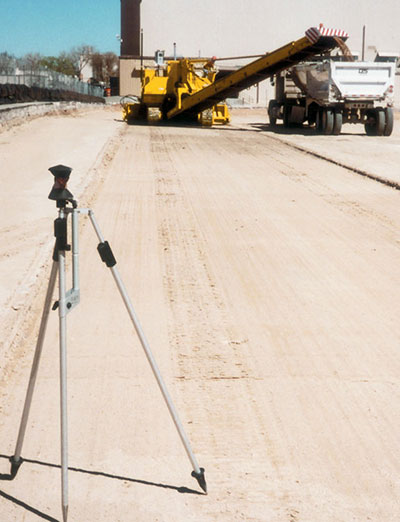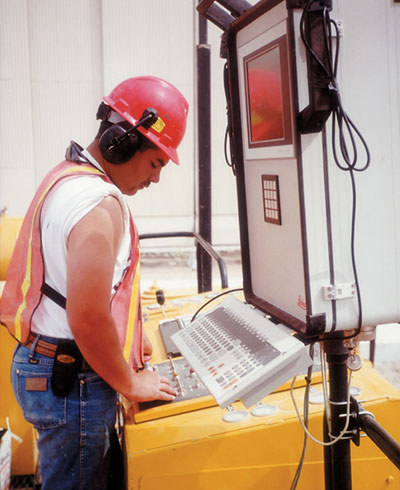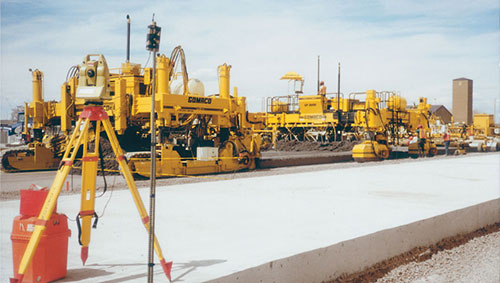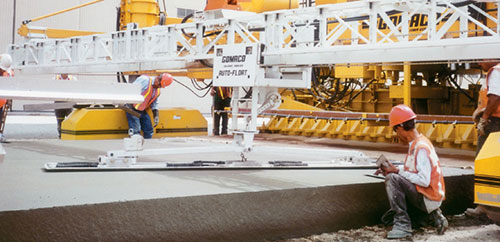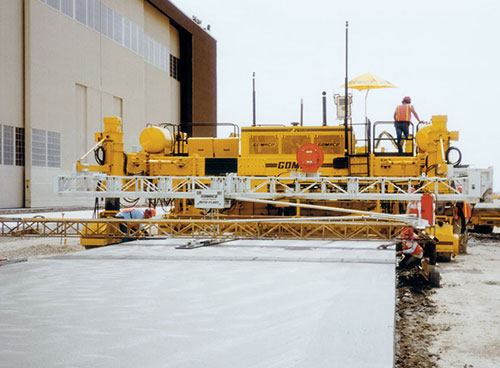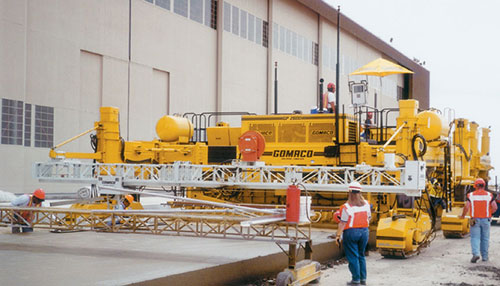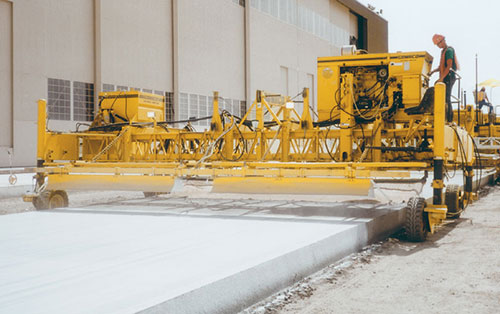GOMACO World Index --- GOMACO World 29.2 - June 2001
Been There, Built That... Stringless
It's 4 a.m. on Kirtland Air Force Base in Albuquerque, New Mexico. For the most part, the base is quiet. For the most part. White trucks bearing the A.S. Horner, Inc., logo and the slogan, "Been There, Built That," are heading to their job site on the base.
A.S. Horner's project: To remove and replace approximately 120,000 yd3 (91,747 m3) of aprons around three large hangars on the base.
A.S. Horner's challenge: The project is for the Corps of Engineers and has several exacting requirements that have to be met.
A.S. Horner's advantages: They're paving with a new GOMACO GP-2600 paver, and they're using the stringless 3-D control system developed by GOMACO and Leica Geosystems on their paver and 9500 trimmer. They also have a new batch plant only five minutes away from their job site.
6:30 a.m.: Preparations are almost complete. The Command Center, the system's computer, is mounted to the GP-2600 paver and connected to the GOMACO controller on the paver.
The entire job site was surveyed with total stations earlier in the project phasing. The information from that survey created the 3-D digital terrain model of the project. The model was then downloaded into the Command Center mounted on the paver.
Three total stations are set up along reference points on the length of the 1231 foot (375 m) pour. A series of shots taken with the total stations to other reference points on the job site bring the total stations into the 3-D picture.
The next step A.S. Horner takes is to bring the paver into the 3-D picture. Shots are taken from the two total stations at two prisms mounted on the paver. The total stations, via radio link, send coordinates back and forth to the Command Center.
"It's taking us an hour and one-half to two hours to set the stringline we needed for each pour," Steve Melton, PCCP paving superintendent for A.S. Horner, said. "It's taking us 35 minutes to set up the stringless system."
7 a.m.: The first concrete trucks arrive from the batch plant and the day's pour begins.
The project is a Corps of Engineers' job with strict guidelines on concrete thickness, smoothness, and finishing requirements. Accurate preparation of the subgrade was critical.
"We came in, broke the existing concrete, hauled it out and did a rough grade on the subgrade," Matts Buckland, superintendent for A.S. Horner, said. "We brought in the GOMACO 9500 with the 3-D control system and trimmed it down to basically perfect."
The grade was then rolled and compacted before a base course was applied and trimmed again to exacting specifications with the 9500.
"We set the trimmer to exact grade because we have a thickness tolerance. If we're below 15 inches (381 mm) with concrete thickness, we have to take it out," Buckland said. "Everything is very precise on this job and the 3-D control system has proven itself on that aspect."
"The trimming aspect is great. We save a lot of time moving the trimmer from one lane to the other. As soon as we're done trimming, we just select the next lane in the program and we're good to go," Melton added. "We don't have to deal with jumping over or resetting stringline or making sure we're at grade. The machine and computer tell us exactly where we're at and how far we need to go to get where we need to be."
The next step is setting load transfer joints. Longitudinal dowels and baskets are placed on the first three joints onto the slab and the last three joints off the slab for load transfer.
Leading A.S. Horner's paving train is a GOMACO PS-60 placer/spreader. "The Corps' spec is, since we're laying this on base course, you cannot dump directly in front of the machine, you have to use a placer/spreader," Buckland said.
A.S. Horner purchased a new GP-2600 paver for the project to meet demanding Corps' specifications for both the weight of the paver and the quality of its end product.
"The Corps' spec says you have to have so much weight per square foot or square inch of mold contact. The GP-2600, we feel, fits this project perfectly," Buckland said. "It's just right weight-wise, it can handle the head of the concrete and give us the quality product we need. We feel the GP-2600 will give us the results we need."
Adding difficulty to the project are the undulations in the slab to help with drainage. A vertical curve or change in vertical elevation every 20 feet (6.2 m) creates high and low spots in the slab.
"The slabs are like roller coasters," Buckland said. "We originally had smoothness specifications we had to meet, but those have been taken out."
Even with the undulations, the last profilographed slab before this article went to press averaged only 3.4 inches per miles (86 mm/km), based on the two-tenths blanking band.
Each lane of concrete is 20 feet (6.1 m) wide and 15 inches (381 mm) thick. The three total stations are set up 328 feet (100 m) apart on the length of the pour to control the paver. Two prisms on the paver are the tracking targets for the total stations.
As the paver moves, it is constantly being tracked by the total stations and the information is relayed back and forth by radio signals to the Command Center at a rate of up to eight times per second. In milliseconds, the Command Center takes the real-time coordinate data and compares it to the design-plan coordinate data. The GOMACO controller uses this information to control the paver.
"You pick points where you want to shoot from and they become your reference points," Melton said. "Shots taken from the reference points tell the machine where it's at and where it needs to be."
Average concrete slump is one inch (25 mm). Joints are placed every 20 feet (6.1 m).
"We had an outside source design the mix using the aggregates and materials that we have locally," Buckland said. "It's known as a 650 flex with a four-sack mix. We're only using three types of aggregate, a washed sand, a .75 inch (19 mm) blend, and a 1.5 inch (38 mm). The .75 and 1.5 inch (19 and 38 mm) aggregate is all crushed so that gives us more fracture faces which provides us more strength."
A.S. Horner's batch plant averages 120 yd3 (92 m3) of concrete production an hour. Seven trucks each haul 10 yd3 (7.64 m3) of concrete to the paver.
The Corp requires very little hand finishing work. Buckland explained, "The Corps of Engineers would prefer that my finishers don't touch the slab and let the paver do what it's supposed to do."
"We're getting the vertical edge the spec calls for and the finish is excellent," Melton said. "The elevations are right on grade and we haven't had any problems."
An Auto-Float® mounted on the back of the GP-2600 is part of the finishing process.
"I like the way it works," Buckland said. "I think, because it oscillates, it applies a better finish and I like the texture."
A T/C-400B texture/cure machine completed the paving train. A burlap drag finish and a Corps of Engineers' white pigment cure was applied to the slab.
1:30 p.m.: The paver has completed over half of the day's run and it's time to switch control of the paver from one total station to the next.
It's a process called leap frogging and the transition from one total station to the next is accomplished with only a slight pause in the forward travel of the paver.
"You shoot your total stations into position before the switch is made and you're good to go," Melton said. "The new station takes over for the last one and just keeps right on tracking the paver. It's a smooth transition."
A.S. Horner, when they reach full production on the project, plans to slipform five lanes a week and average approximately 1200 yd3 (917 m3) a day production.
Fill-in lanes are also being paved with the GP-2600 and the stringless guidance system. Slabs are 19.5 feet (5.94 m) wide and 15 inches (381 mm) thick.
"The crew lacks some experience," Buckland said. "The learning is all basically hands on. They're good workers. The heart is there, the passion is there, the only thing is the knowledge. The bugs are being worked out and we're moving in the right direction."
Organization is also a major factor needed to successfully complete a project of this size. Buckland is in charge of keeping everybody involved with the project up to date, including his own workers, the Corps of Engineers and air base officials.
"We have a lot of boards in our job office trailer that cover every aspect of the work," Buckland said. "Each week a new three-week schedule is posted and we stick to that as closely as possible. We try to be realistic with the schedule, but we also try to set goals to step up to the next level."
The four-phase project covering 300,000 yd2 (250,830 m2) of area is scheduled for completion by late spring 2002.
"This project has been a new adventure. The stringless system has been interesting to learn and a bit of a challenge to get the computer aspect, but everything has a little bit of a learning curve. Once we grasped the concept, it's been wonderful. There's just no comparing it to stringline," Melton said.
Editor's Note: A.S. Horner used stringline to steer their PS-60 placer/spreader and manually steered their T/C-400B texture/cure. The stringless system was used on the GP-2600 paver and 9500 trimmer.
Subscribe to Receive GOMACO World Magazine
